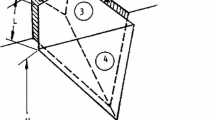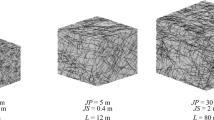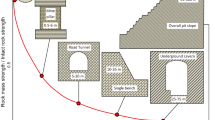Abstract
The shape, the volume, and the distribution of the rock blocks represent important geomechanical factors of a rock mass behavior in engineering works. Several methods have been developed for estimating these parameters, including numerical models, as well as analytical and empirical methods. However, their determination in actual in-situ conditions can be quite challenging. The existing analytical methods show limitations in determining the in-situ rock blocks volume. Numerical models provide more reliable estimates of these parameters, but they are not accessible to all, and they require a good working knowledge. Increasing the accuracy of existing analytical methods, or developing more reliable and accessible methods, are more realistic approaches to obtain better estimates of rock block volumes. This paper presents a new method to obtain more accurate estimates of in-situ rock block volume. The method is developed for rock a mass consisting of three persistent joint sets, each set having constant spacing and orientation values. It is based on vector products to obtain exact block volumes, an improvement as compared to previous methods. The volumes of the rock blocks are calculated through the multiplication of the blocks’ edge vector. The results of the developed equation are validated with the output of numerical simulations using 3DEC version 7.0 software, and the results indicate that the developed method makes it possible to determine in-situ rock block volume more reliably than the existing methods.








Similar content being viewed by others
Data availability
All data, models, and code generated or used during the study appear in the paper (Tables and Appendix).
Abbreviations
- (.):
-
The point is an inner product of a pair of vectors
- (×):
-
The multiplication sign is a cross product
- A :
-
The area of the observation zone (m2)
- \(\overset{\lower0.5em\hbox{$\smash{\scriptscriptstyle\rightharpoonup}$}} {A} , \overset{\lower0.5em\hbox{$\smash{\scriptscriptstyle\rightharpoonup}$}} {B} , \overset{\lower0.5em\hbox{$\smash{\scriptscriptstyle\rightharpoonup}$}} {C}\) :
-
Edge vectors of the intact block
- a 1 :
-
Longest dimension of the block (m)
- a 3 :
-
Shortest dimension of the block (m)
- D 1, D 2, and D 3 :
-
Dips of the joint sets 1, 2, and 3
- DD1, DD2, and DD3 :
-
Dip directions of the joint sets 1, 2, and 3
- E doa :
-
Erosion, discontinuity orientation adjustment
- J a :
-
Joint alteration number
- J n :
-
Number of joint sets
- J o :
-
Joint aperture (m)
- J r :
-
Joint roughness number
- J s :
-
Relative block structure
- J v :
-
Number of joints intersecting a volume of 1 m3 of rock (m−3)
- L :
-
Characteristic length of the rock mass (m)
- l i :
-
Joint length (m)
- N J 1, N J 2, and N J 3 :
-
Normal vectors to joint sets J1, J2, and J3 plane
- N r :
-
Number of random joints in the real location
- P i :
-
Joint persistence
- RQD:
-
Rock quality designation
- RMSE:
-
Root mean square error
- S :
-
Average joint spacing measured along the drill core (m)
- S a :
-
Average joint spacing of all sets (m)
- S i :
-
Average spacing of joint set i (m)
- \(\overset{\lower0.5em\hbox{$\smash{\scriptscriptstyle\rightharpoonup}$}}{{u_{A} }}, \overset{\lower0.5em\hbox{$\smash{\scriptscriptstyle\rightharpoonup}$}}{{u_{B} }}, \overset{\lower0.5em\hbox{$\smash{\scriptscriptstyle\rightharpoonup}$}}{{u_{C} }}\) :
-
Unit vectors of \(\overset{\lower0.5em\hbox{$\smash{\scriptscriptstyle\rightharpoonup}$}} {A} , \overset{\lower0.5em\hbox{$\smash{\scriptscriptstyle\rightharpoonup}$}} {B} , \overset{\lower0.5em\hbox{$\smash{\scriptscriptstyle\rightharpoonup}$}} {C}\)
- V b :
-
Volume of blocks (m3)
- V b A :
-
The analytically calculated block volume (m3)
- wJd:
-
Weighted joint density
- γ 1, γ 2, and γ 3 :
-
Angle between each pair of joint sets
- β :
-
Form factor of the blocks
References
Aksoy CO, Geniş M, UyarAldaş G, Özacar V, Özer SC, Yılmaz Ö (2012) A comparative study of the determination of rock mass deformation modulus by using different empirical approaches. Eng Geol 131–132:19–28
Andreescu T, Gelca R (2008) Mathematical olympiad challenges. Springer Science & Business Media, Berlin
Annandale G (1995) Erodibility. J Hydraul Res 33:471–494
Assali P, Grussenmeyer P, Villemin T, Pollet N, Viguier F (2014) Surveying and modeling of rock discontinuities by terrestrial laser scanning and photogrammetry: semi-automatic approaches for linear outcrop inspection. J Struct Geol 66:102–114
Azarafza M, Nanehkaran YA, Rajabion L, Akgün H, Rahnamarad J, Derakhshani R, Raoof A (2020) Application of the modified Q-slope classification system for sedimentary rock slope stability assessment in Iran. Eng Geol 264:105349
Azarafza M, Koçkar MK, Faramarzi L (2021) Spacing and block volume estimation in discontinuous rock masses using image processing technique: a case study. Environ Earth Sci 80:1–13
Azizi A, Moomivand H (2021) A new approach to represent impact of discontinuity spacing and rock mass description on the median fragment size of blasted rocks using image analysis of rock mass. Rock Mech Rock Eng 54:2013–2038
Barton N, Lien R, Lunde J (1974) Engineering classification of rock masses for the design of tunnel support. Rock Mech 6:189–236
Bieniawski ZT (1989) Engineering rock mass classifications: a complete manual for engineers and geologists in mining, civil, and petroleum engineering. Wiley, New York
Buyer A, Pischinger G, Schubert W (2018) Image-based discontinuity identification: Bildgestützte Trennflächenidentifikation. Geomech Tunn 11:693–700
Buyer A, Aichinger S, Schubert W (2020) Applying photogrammetry and semi-automated joint mapping for rock mass characterization. Eng Geol 264:105332
Cai M, Kaiser P, Uno H, Tasaka Y, Minami M (2004a) Estimation of rock mass deformation modulus and strength of jointed hard rock masses using the GSI system. Int J Rock Mech Min Sci 41:3–19
Chen Q, Yin T (2020) Modification of the rock mass rating system (RMR mbi) considering three-dimensional rock block size. Bull Eng Geol Environ 79:789–810
Deere DU (1964) Technical description of rock cores for engineering purpose. Rock Mech Eng Geol 1:17–22
Elci H, Turk N (2014) Block volume estimation from the discontinuity spacing measurements of Mesozoic limestone quarries, Karaburun Peninsula, Turkey. Sci World J 2014:363572
Elmo D, Rogers S, Stead D, Eberhardt E (2014) Discrete fracture network approach to characterise rock mass fragmentation and implications for geomechanical upscaling. Min Technol 123:149–161
Elmouttie MK, Poropat G (2012) A method to estimate in situ block size distribution. Rock Mech Rock Eng 45(3):401–407
Gaich A, Pischinger G (2016) 3D images for digital geological mapping: focussing on conventional tunnelling. Geomech Tunn 9:45–51
Ghaedi Ghalini M, Bahaaddini M, Amiri HM (2022) Estimation of in-situ block size distribution in jointed rock masses using combined photogrammetry and discrete fracture network. J Min Environ 13:175–184
Gottron D, Henk A (2021) Upscaling of fractured rock mass properties—an example comparing discrete fracture network (DFN) modeling and empirical relations based on engineering rock mass classifications. Eng Geol 294:106382
Grenon M, Hadjigeorgiou J (2008) A design methodology for rock slopes susceptible to wedge failure using fracture system modelling. Eng Geol 96:78–93
Gringarten AC (1984) Interpretation of tests in fissured and multilayered reservoirs with double-porosity behavior: theory and practice. J Petrol Technol 36:549–564
Hoek E, Carter T, Diederichs M (2013) Quantification of the geological strength index chart. In: Dans: 47th US rock mechanics/geomechanics symposium. OnePetro
Huang R, Huang J, Ju N, Li Y (2013) Automated tunnel rock classification using rock engineering systems. Eng Geol 156:20–27
Hudson JA, Priest SD (1979) Discontinuities and rock mass geometry. Int J Rock Mech Min Sci Geomech Abstr 16:339–362
Itasca Consulting Group I (2021) 3DEC—three-dimensional distinct element code. Itasca, Minneapolis
Jia B, Tsau J-S, Barati R (2019) A review of the current progress of CO2 injection EOR and carbon storage in shale oil reservoirs. Fuel 236:404–427
Kalenchuk KS, Diederichs MS, McKinnon S (2006) Characterizing block geometry in jointed rockmasses. Int J Rock Mech Min Sci 43:1212–1225
Kalenchuk KS, McKinnon S, Diederichs MS (2008) Block geometry and rockmass characterization for prediction of dilution potential into sub-level cave mine voids. Int J Rock Mech Min Sci 45:929–940
Kattan P (2009) Math notebook for students: 350 essential mathematical formulas and equations. Petra Books, Ottawa
Kazi A, Sen Z (1985) Volumetric RQD: an index of rock quality. In: Dans: international symposium on fundamentals of rock joints, pp 95–102
Kim B, Cai M, Kaiser P, Yang H (2007) Estimation of block sizes for rock masses with nonpersistent joints. Rock Mech Rock Eng 40:169–192
Kim BH, Peterson RL, Katsaga T, Pierce ME (2015) Estimation of rock block size distribution for determination of geological strength index (GSI) using discrete fracture networks (DFNs). Min Technol 124:203–211
Kluckner A, Söllner P, Schubert W, Pötsch M (2015) Estimation of the in situ block size in jointed rock masses using three-dimensional block simulations and discontinuity measurements. In: Dans: 13th ISRM international congress of rock mechanics, 2015. OnePetro
Latham J-P, Van Meulen J, Dupray S (2006) Prediction of in-situ block size distributions with reference to armourstone for breakwaters. Eng Geol 86:18–36
Li X, Chen Z, Chen J, Zhu H (2019) Automatic characterization of rock mass discontinuities using 3D point clouds. Eng Geol 259:105131
Lopes P, Lana M (2017) Analytical method for calculating the volume of rock blocks using available mapping data field. Math Geosci 49:217–229
Lu P, Latham J-P (1999) Developments in the assessment of in-situ block size distributions of rock masses. Rock Mech Rock Eng 32:29–49
Ma C, Yao W, Yao Y, Li J (2018) Simulating strength parameters and size effect of stochastic jointed rock mass using DEM method. KSCE J Civ Eng 22:4872–4881
Moomivand H, Seadati S, Allahverdizadeh H (2021) A new approach to improve the assessment of rock mass discontinuity spacing using image analysis technique. Int J Rock Mech Min Sci 143:104760
Palmström A (1995) RMi—a rock mass characterization system for rock engineering purposes. University of Oslo, Oslo
Palmström A (2005) Measurements of and correlations between block size and rock quality designation (RQD). Tunn Undergr Space Technol 20:362–377
Palmstrom A (2005) Measurements of and correlations between block size and rock quality designation (RQD). Tunn Undergr Space Technol 20:362–377
Palmström A (1982) The volumetric joint count—a useful and simple measure of the degree of rock mass jointing. In: Dans: International Association of Engineering Geology international congress, India/Netherlands. A.A. Balkema, pp 221–228
Palmstrom A (1982) The volumetric joint count—a useful and simple measure of the degree of rock mass jointing. In: Dans: International Association of Engineering Geology international congress 4, pp 221–228
Palmström A (1996) The Rock Mass Index (RMi) applied in rock mechanics and rock engineering. J Rock Mech Tunn Technol 2:40
Pells S (2016) Erosion of rock in spillways. University of New South Wales, Sydney
Priest SD, Hudson J (1976) Discontinuity spacings in rock. Dans Int J Rock Mech Min Sci Geomech Abstr 13:135–148
Proulx J, Pimm D (2008) Algebraic formulas, geometric awareness and Cavalieri’s principle. Learn Math 28:17–24
Riquelme AJ, Abellán A, Tomás R, Jaboyedoff M (2014) A new approach for semi-automatic rock mass joints recognition from 3D point clouds. Comput Geosci 68:38–52
Shahbazi A, Saeidi A, Chesnaux R (2021a) Dependency of the average inflow rate to the tunnel excavated in a fractured rock mass to its length and direction. GeoNiagara, Niagara Falls, ON, CA
Shahbazi A, Saeidi A, Chesnaux R, Rouleau A (2021b) The specific length of an underground tunnel and the effects of rock block characteristics on the inflow rate. Geosciences 11(12):517
Singh HK, Basu A (2018) Evaluation of existing criteria in estimating shear strength of natural rock discontinuities. Eng Geol 232:171–181
Slob S (2010) Automated rock mass characterisation using 3-D terrestrial laser scanning. Ph.D. Dissertation. Delft University of Technology, Delft, Netherlands, pp 44
Stavropoulou M (2014) Discontinuity frequency and block volume distribution in rock masses. Int J Rock Mech Min Sci 65:62–74
Stavropoulou M, Xiroudakis G (2020) Fracture frequency and block volume distribution in rock masses. Rock Mech Rock Eng 53:4673–4689
Umili G, Bonetto SMR, Mosca P, Vagnon F, Ferrero AM (2020) In situ block size distribution aimed at the choice of the design block for rockfall barriers design: a case study along Gardesana road. Geosciences 10:223
Vazaios I, Farahmand K, Vlachopoulos N, Diederichs MS (2018) Effects of confinement on rock mass modulus: a synthetic rock mass modelling (SRM) study. J Rock Mech Geotech Eng 10:436–456
Wang X, Ding W, Cui L, Wang R, He J, Li A, Gu Y, Liu J, Xiao Z, Fu F (2018) The developmental characteristics of natural fractures and their significance for reservoirs in the Cambrian Niutitang marine shale of the Sangzhi block, southern China. J Petrol Sci Eng 165:831–841
Yarahmadi R, Bagherpour R, Taherian S-G, Sousa LMO (2018) Discontinuity modelling and rock block geometry identification to optimize production in dimension stone quarries. Eng Geol 232:22–33
Acknowledgements
The authors would like to thank the Natural Sciences and Engineering Research Council of Canada (NSERC) and Hydro-Québec for the funding provided through the RDC (RDC 537350) Program. Furthermore, the authors wish to convey their deep gratitude to the Itasca Consulting Group in Minneapolis for the IEP Research Program, especially Jim Hazzard, for his valuable technical support and advice.
Funding
Natural Sciences and Engineering Research Council of Canada (NSERC), Hydro-Québec for funding through the CRD program (CRD 537350).
Author information
Authors and Affiliations
Contributions
ASK: formal analysis, conceptualization, resources, investigation, data curation, writing—original draft. AS: conceptualization, resources, data curation, software, validation, methodology, writing-original draft. AS: conceptualization, supervision, investigation, methodology, project administration, writing—review and editing. AR: conceptualization, supervision, writing—review and editing. MQ: funding acquisition, writing—review and editing. RC: supervision, writing—review and editing.
Corresponding author
Ethics declarations
Conflict of interest
The authors declare that there is no conflict of interest associated with this publication.
Additional information
Publisher's Note
Springer Nature remains neutral with regard to jurisdictional claims in published maps and institutional affiliations.
Electronic supplementary material
Below is the link to the electronic supplementary material.
Appendices
Appendix 1
See Table 6.
Appendix 2
This information is taken from: Itasca Consulting Group Inc, 2016. 3DEC: 3 Dimensional Distinct Element Code. Online Manual (http://docs.itascacg.com/3dec700/3dec/docproject/source/theory/3dectheory/theory_background.html?node2134)
«The space containing the system of blocks is divided into rectangular 3D cells. Each block is mapped into the cell or cells that its “envelope space” occupies. A block’s envelope space is defined as the smallest three-dimensional box with sides parallel to the coordinate axes that can contain the block. Each cell stores, in linked-list form, the addresses of all blocks that map into it. Following Fig. 9 illustrates the mapping logic for a two-dimensional space (as it is difficult to illustrate the concept in three dimensions). Once all blocks have been mapped into the cell space, it is an easy matter to identify the neighbors to a given block: the cells that correspond to its envelope space contain entries for all blocks that are near. Normally, this “search space” is increased in all directions by a tolerance, so that all blocks within the given tolerance are found. Note that the computer time necessary to perform the map and search functions for each block depends on the size and shape of the block, but not on the number of blocks in the system. The overall computer time for neighbor detection is consequently directly proportional to the number of blocks, provided that cell volume is proportional to average block volume. It is difficult to provide a formula for optimum cell size because of the variety of block shapes that may be encountered. In the limit, if only one cell is used, all blocks will map into it, and the search time will be quadratic. As the density of cells increases, the number of non-neighboring blocks retrieved for a given block will decrease. At a certain point, there is no advantage to increasing the density of cells, because all the blocks retrieved will be neighbors. However, by further increasing the cell density, the time associated with mapping and searching increases. The optimum cell density must therefore be of the order of one cell per block, in order to reduce both sources of wasted time.
Rights and permissions
Springer Nature or its licensor (e.g. a society or other partner) holds exclusive rights to this article under a publishing agreement with the author(s) or other rightsholder(s); author self-archiving of the accepted manuscript version of this article is solely governed by the terms of such publishing agreement and applicable law.
About this article
Cite this article
Koulibaly, A.S., Shahbazi, A., Saeidi, A. et al. Advancements in rock block volume calculation by analytical method for geological engineering applications. Environ Earth Sci 82, 344 (2023). https://doi.org/10.1007/s12665-023-11027-6
Received:
Accepted:
Published:
DOI: https://doi.org/10.1007/s12665-023-11027-6





